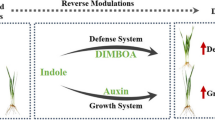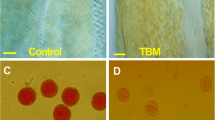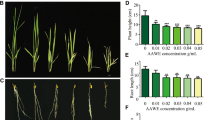Abstract
Understanding how herbicides affect plant reproduction and growth is critical to develop herbicide toxicity model and refine herbicide risk assessment. Although our knowledge of herbicides toxicity mechanisms at the physiological and molecular level in plant vegetative phase has increased substantially in the last decades, few studies have addressed the herbicide toxicity problematic on plant reproduction. Here, we determined the long-term (4–8 weeks) effect of a chiral herbicide, imazethapyr (IM), which has been increasingly used in plant crops, on floral organ development and reproduction in the model plant Arabidopsis thaliana. More specifically, we followed the effect of two IM enantiomers (R- and S-IM) on floral organ structure, seed production, pollen viability and the transcription of key genes involved in anther and pollen development. The results showed that IM strongly inhibited the transcripts of genes regulating A. thaliana tapetum development (DYT1: DYSFUNCTIONAL TAPETUM 1), tapetal differentiation and function (TDF1: TAPETAL DEVELOPMENT AND FUNCTION1), and pollen wall formation and developments (AMS: ABORTED MICROSPORES, MYB103: MYB DOMAIN PROTEIN 103, MS1: MALE STERILITY 1, MS2: MALE STERILITY 2). Since DYT1 positively regulates 33 genes involved in cell-wall modification (such as, TDF1, AMS, MYB103, MS1, MS2) that can catalyze the breakdown of polysaccharides to facilitate anther dehiscence, the consistent decrease in the transcription of these genes after IM exposure should hamper anther opening as observed under scanning electron microscopy. The toxicity of IM on anther opening further lead to a decrease in pollen production and pollen viability. Furthermore, long-term IM exposure increased the number of apurinic/apyrimidinic sites (AP sites) in the DNA of A. thaliana and also altered the DNA of A. thaliana offspring grown in IM-free soils. Toxicity of IM on floral organs development and reproduction was generally higher in the presence of the R-IM enantiomer than of the S-IM enantiomer. This study unraveled several IM toxicity targets and mechanisms at the molecular and structural level linked to the toxicity of IM trace concentrations on A. thaliana reproduction.






Similar content being viewed by others
References
Aarts MG, Hodge R, Kalantidis K, Florack D, Wilson ZA, Mulligan BJ, Stiekema WJ, Scott R, Pereira A (1997) The Arabidopsis MALE STERILITY 2 protein shares similarity with reductases in elongation/condensation complexes. Plant J 12:615–623
Amasino R (2010) Seasonal and developmental timing of flowering. Plant J 61:1001–1013
Apel K, Hirt H (2004) Reactive oxygen species: metabolism, oxidative stress, and signal transduction. Annu Rev Plant Biol 55:373–399
Baucom RS, Mauricio R, Chang SM (2008) Glyphosate induces transient male sterility in Ipomoea purpurea. Botany 86:587–594
Boatman ND, Parry HR, Bishop JD, Cuthbertson AGS (2007) Impacts of agricultural change for farmland biodiversity. In: Hester R, Harrison RM (eds) Biodiversity under threat. The Royal Society of Chemistry, Cambridge
Boutin C, Standberg B, Carpenter D, Mathiassen SK, Thomas PJ (2014) Herbicide impact on non-target plant reproduction: what are the toxicological and ecological implications? Environ Poll 185:295–306
Carpenter C, Boutin C (2010) Sublethal effects of the herbicide glufosinate ammonium on crops and wild plants: short-term effects compared to vegetative recovery and plant reproduction. Ecotoxicology 19:1322–1336
Curran WC, Liebl RA, Simmons FW (1992) Effects of tillage and application method on clomazone, imazaquin and imazethapyr persistence. Weed Sci 40:482–489
Dalton RL, Boutin C (2010) Comparison of the effects of glyphosate and atrazine herbicides on nontarget plants grown singly and in microcosms. Environ Toxicol Chem 29:2304–2315
Demura T, Ye ZH (2010) Regulation of plant biomass production. Curr Opin Plant Biol 13:299–304
Feng B, Lu D, Ma X, Peng Y, Sun Y, Ning G, Ma H (2012) Regulation of the Arabidopsis anther transcriptome by DYT1 for pollen development. Plant J 72:612–624
Fletcher SJ, Pfleeger TG, Hillman CR (1993) Potential environmental risks associated with the new sulfonylurea herbicides. Environ Sci Technol 27:2250–2252
Fletcher JS, Pfeeger TG, Ratsch HC, Hayes R (1996) Potential impact of low levels of chlorosulfuron and other herbicides on growth and yield of nontarget plants. Environ Toxicol Chem 15:1189–1196
Gavrilescu M (2005) Fate of pesticides in the environment and its bioremediation. Eng Life Sci 5:497–525
Gealy DR, Boerboom CM, Ogg AG Jr (1995) Growth and yield of pea (Pisum sativum L) and lentil (Lens culinaris L) sprayed with low rates of sulfonylurea and phenoxy herbicide. Weed Sci 43:640–647
Huijser P, Schmid M (2011) The control of developmental phase transitions in plants. Development 138:4117–4129
Jettner RJ, Walker SR, Churchett JD, Blameye FC, Adkins SW, Bell K (1999) Plant sensitivity to atrazine and chlorsulfuron residues in a soil-free system. Weed Res 39:287–295
Kumar SV, Lucyshyn D, Jaeger KE, Alós E, Alvey E, Harberd NP, Wigge PA (2012) Transcription factor PIF4 controls the thermo sensory activation of flowering. Nature 484:242–245
Lambrev P, Ivanov S, Goltsev V (2003) Effect of prolonged action of sub-herbicide concentration of atrazine on the photosynthetic function of pea plants. Comp Rend Acad Bulg Sci 56:59–62
Lansac AR, Sullivan CY, Johnson E, Lee KW (1994) Viability and germination of the pollen of sorghum [Sorghum bicolor (L.) Moench]. Ann Bot 74:27–33
Livak KJ, Schmittgen TD (2001) Analysis of relative gene expression data using real-time quantitative PCR and the 2−ΔΔCt method. Methods 25:402–408
Mills JA, Witt WW (1989) Efficacy, phytotoxicity, and persistence of imazaquin, imazethapyr, and clomazone in non-till double crop soybeans (Glycine max). Weed Sci 37:353–359
Ó’Maoiléidigh DS, Graciet E, Wellmer F (2013) Gene networks controlling Arabidopsis thaliana flower development. New Phytol 201:16–30
Olofsdotter M, Watson A, Piggin C (1998) Weeds: a looming problem in modern rice production. In: Dowling NG, Greenfield SM, Fisher KS (eds) Sustainability of rice in the global food system. Davis, California, pp 165–173
Pimentel D (1995) Amounts of pesticides reaching target pests: environmental impacts and ethics. J Agr Environ Ethic 8:17–29
Pline WA, Viator R, Wilcut JW, Edmisten KL, Thomas J, Wells R (2002) Reproductive abnormalities in glyphosate-resistant cotton caused by lower CP4-EPSPS levels in the male reproductive tissue. Weed Sci 50:438–447
Qian HF, Hu HJ, Ma J, Mao Y, Zhang A, Liu WP, Fu Z (2009) Enantioselective phytotoxicity of the herbicide imazethapyr in rice. Chemosphere 76:885–892
Qian HF, Lu T, Peng X, Han X, Fu Z, Liu W (2011a) Enantioselective phytotoxicity of the herbicide imazethapyr on the response of the antioxidant system and starch metabolism in Arabidopsis thaliana. PLoS ONE 6:e19451
Qian HF, Wang R, Hu H, Lu T, Chen X, Ye H, Liu W, Fu Z (2011b) Enantioselective phytotoxicity of the herbicide imazethapyr and its effect on rice physiology and gene transcription. Environ Sci Technol 45:7036–7043
Qian HF, Han X, Zhang Q, Sun Z, Sun L, Fu Z (2013) Imazethapyr enantioselectively affects chlorophyll synthesis and photosynthesis in Arabidopsis thaliana. J Agric Food Chem 61:1172–1178
Qian HF, Han X, Peng X, Lu T, Liu W, Fu Z (2014) The circadian clock gene regulatory module enantioselectively mediates Imazethapyr-induced early flowering in Arabidopsis thaliana. J Plant Physiol 171:92–98
Ratsch HC, Johndro DJ, McFarlane JC (1986) Growth inhibition and morphological effects of several chemicals in Arabidopsis thaliana (L.) Heynh. Environ Toxicol Chem 5:55–60
Satake A, Kawagoe T, Saburi Y, Chiba Y, Sakurai G, Kudoh H (2013) Forecasting flowering phenology under climate warming by modeling the regulatory dynamics of flowering-time genes. Nat Commun 4:2303
Singh BK (1999) Biosynthesis of valine, leucine and isoleucine. In: Singh BK (ed) Plant amino acids: biochemistry and biotechnology. Marcel Dekker, New York, pp 227–247
Strandberg B, Mathiassen SK, Bruus M, Kjær C, Damgaard C, Andersen HV, Bossi R, Løfstrøm P, Larsen SE, Bak J, Kudsk P (2012) Effects of herbicides on non-target plants: how do effects in standard plant test relate to effects in natural habitats? Pesticide Research No 137, Danish Ministry of the Environment, EPA, p 114. http://www2.mst.dk/udgiv/publications/2012/06/978-87-92779-53-3.pdf
Su Z, Ma X, Guo H, Sukiran NL, Guo B, Assmann SM, Ma H (2013) Flower Development under Drought Stress: morphological and transcriptomic analyses reveal acute responses and long-term acclimation in Arabidopsis. Plant Cell 25:3785–3807
Thomas WE, Pline-Srnie WA, Thomas JF, Edmisten KL, Wells R, Wileut JW (2004) Glyphosate negatively affects pollen viability but not pollination and seed set in glyphosate-resistant corn. Weed Sci 52:725–734
Thorstensen T, Grini PE, Mercy IS, Alm V, Erdal S, Aasland R, Aalen RB (2008) The Arabidopsis SET-domain protein ASHR3 is involved in stamen development and interacts with the bHLH transcription factor ABORTED MICROSPORES (AMS). Plant Mol Biol 66:47–59
Wang XL, Takai T, Kamijo S, Gunawan H, Ogawa H, Okumura K (2009) NADPH oxidase activity in allergenic pollen grains of different plant species. Biochem Bioph Res Co 387:430–434
Yasuor H, Abu-Abied M, Belausov E, Madmony A, Sadot E, Riov J, Rubin B (2006) Glyphosate-induced anther indehiscence in cotton is partially temperature dependent and involves cytoskeleton and secondary wall modifications and auxin accumulation. Plant Physiol 141:1306–1315
York AC, Wilcut JW, Swann CW, Jordan DL, Walls R Jr (1995) Efficacy of imazethapyr in peanut (Arachis hypogaea) as affected by time of application. Weed Sci 43:107–116
Zabaloy MC, Zanini GP, Bianchinotti V, Gomez MA, Garland JL (2011) Herbicides in the soil environment: linkage between bioavailability and microbial ecology. In: Soloneski S, Larramendy ML (eds) Inherbicides, theoryand applications. Croatia, Intech, pp 161–192
Zhang W, Sun Y, Timofejeva L, Chen C, Grossniklaus U, Ma H (2006) Regulation of Arabidopsis tapetum development and function by DYSFUNCTIONAL TAPETUM1 (DYT1) encodinga putative bHLH transcription factor. Development 133:3085–3095
Zhu J, Chen H, Li H, Gao JF, Jiang H, Wang C, Guan YF, Yang ZN (2008) Defective in Tapetal Development and Function 1 is essential for anther development and tapetal function for microspore maturation in Arabidopsis. Plant J 55:266–277
Zhu J, Lou Y, Xu X, Yang ZN (2011) A genetic pathway for tapetum development and function in Arabidopsis. J Integr Plant Biol 53:892–900
Acknowledgments
This work was financially supported by the Natural Science Foundation of China (21277127, 21277125), and Zhejiang Provincial Natural Science Foundation of China (LR14B070001).
Conflict of interest
The authors declare that they have no conflict of interest.
Author information
Authors and Affiliations
Corresponding author
Rights and permissions
About this article
Cite this article
Qian, H., Li, Y., Sun, C. et al. Trace concentrations of imazethapyr (IM) affect floral organs development and reproduction in Arabidopsis thaliana: IM-induced inhibition of key genes regulating anther and pollen biosynthesis. Ecotoxicology 24, 163–171 (2015). https://doi.org/10.1007/s10646-014-1369-5
Accepted:
Published:
Issue Date:
DOI: https://doi.org/10.1007/s10646-014-1369-5




